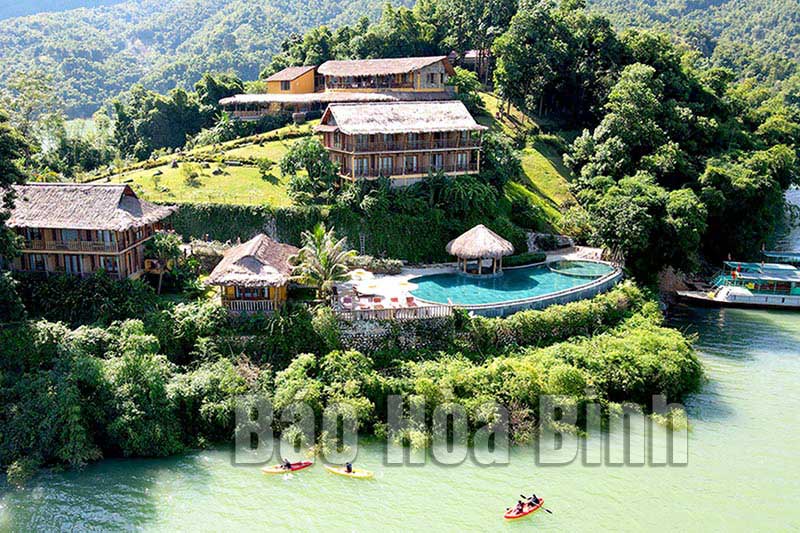
(HBO) – In the context that the lingering COVID-19 pandemic has severely affected tourism, Hoa Binh province is still one of the few localities in the northern region to record a stable number of visitors and have tourism activities not suspended for too long. Since late 2021, local tourism has been reactivated and rebounded strongly.
Mai Chau Hideaway in Son Thuy commune (Mai Chau district) is one of the
pandemic-free eco-resort sites with a beautiful natural landscape on Hoa Binh
Lake.
Aside from promoting domestic travel with
COVID-19 safety ensured, the tourism sector in Hoa Binh has been taking actions
to flexibly adapt to the pandemic, prepare for welcoming more tourists, and
diversify local destinations since Vietnam piloted the border reopening to
international arrivals.
A large number of new tourism products have been
launched to enhance the attractiveness of local destinations. Besides, the Hoa
Binh Tourism Association has encouraged businesses to develop potential types
such as cultural tourism, community-based tourism, eco-tourism, resort tourism,
and sports tourism.
To meet the manpower demand during the tourism
recovery process, authorities have opened several training courses on tourism
skills, sent local cadres and representatives of households to learn
community-based tourism management and development in Lao Cai and Son La provinces.
Hoa Binh has also actively worked to expand
tourism partnerships with northwestern provinces and build tourism cooperation
programmes with major travel hubs such as Ho Chi Minh City, Hanoi, Thanh Hoa,
Quang Ninh, and some nearby localities.
The 17th provincial Party Congress for the 2020
- 2025 tenure targets that tourism will be become a key economic sector. Hoa
Binh looks to attract 4.9 million tourist arrivals, including 1 million foreign
visitors, earn 5.4 trillion VND (236.2 million USD) from tourism, and create
about 26,000 jobs in this industry by 2025.
Photo:
Visitors to Tien Pagoda in Lac Thuy district seriously comply with
anti-pandemic rules.
For 2022, the tourism sector hopes to welcome
more than 2.5 million tourists and rake in over 2.4 trillion VND in revenue
which is expected to reach 900 billion VND in the first quarter, up 60 percent
year on year.
Nguyen Van Toan, Standing Vice Chairman of the
provincial People’s Committee, stressed that Hoa Binh now has a chance to
popularise itself as a safe, hospitable, and attractive destination among
travelers nationwide, especially those in Hanoi and HCM City.
This March, the provincial People’s Committee
and national flag carrier Vietnam Airlines are scheduled to sign a deal on a
comprehensive cooperation programme for 2022 - 2026 and an action plan for 2022
- 2023. Hoa Binh and other provinces in the expanded northwestern region have
also inked a cooperation agreement and planned to set up a safe tourism
corridor.
Located just a 20-minute drive from Hoa Binh City, Ora Hill Farmstay & Glamping Hoa Binh is a captivating new destination nestled in Mo hamlet, Bình Thanh commune, Cao Phong district. Combining farming with leisure, this tranquil retreat is perfect for those seeking balance, joy, and an immersive experience in the expansive beauty of nature.
Muong Bi - Tan Lac is renowned as one of the four famous Muong regions in Hoa Binh province. Blessed by nature with a favourable climate and stunning landscapes, Tan Lac holds great advantages for tourism development. The local tourism industry has made remarkable strides in recent times thanks to the attention and support from the local authorities and sectors.
With its strategic location, well-developed transport network, and diverse soil and climatic conditions, Hoa Binh is emerging as a must-visit destination in Vietnam's northwestern tourism corridor. The province boasts numerous attractions, including the Kim Boi hot springs (Kim Boi district), the Dau Rong cave complex (Cao Phong), the Mai Chau valley (Mai Chau), and the iconic Hoa Binh hydropower plant.
The northern mountainous province of Hoa Binh has been listed among the 71 most beautiful places to visit worldwide by the prestigious US travel magazine Condé Nast Traveller.
Hoa Binh province’s rich natural and cultural resources position it as a prime location for developing community-based tourism (CBT). In recent years, support from central and provincial policies, as well as assistance from non-governmental organisations, have encouraged local ethnic minority and mountainous communities to actively engage in the sector.



